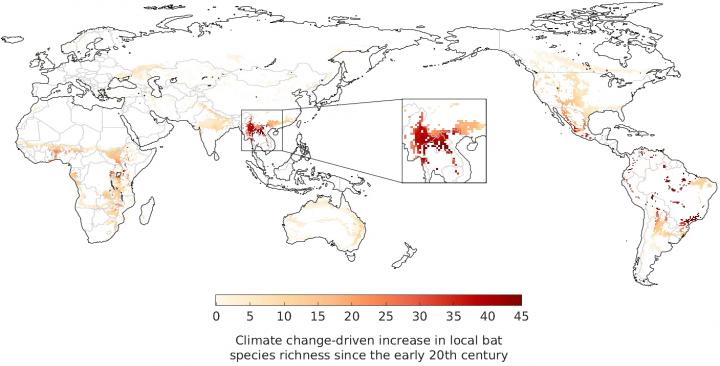A research result showing that climate change directly played a role in the emergence of’SARS-CoV-2′, a virus that caused the Corona 19 pandemic, is drawing attention recently.
It is argued that global greenhouse gas emissions over the past century have made southern China a’hotspot’ for the coronavirus by promoting the growth of forest habitats favored by bats.
The results of this study, published by international collaborators at Cambridge University in the UK and the University of Hawaii in the US, were published in the international journal Science of the Total Environment on February 5th.
A research result was announced that it was climate change that played a direct role in the emergence of’SARS-CoV-2′, a virus that caused the Corona 19 pandemic. ⒸGetty Image Bank
–
According to him, over the past century, there have been significant changes in plant types in southern China’s Yunnan provinces and neighboring areas of Myanmar and Laos. Climate change, including increases in temperature, sunlight, and carbon dioxide, which affect tree growth, has transformed the tropical shrubland, where tall trees mainly grow, into tropical savannah and deciduous forests. This is a suitable environment for bat species that live mainly in forests.
In fact, the number of coronaviruses in a particular region is closely related to the number of different bat species that live there. The researchers found that about 100 more bat-borne coronaviruses have risen over the past century with an additional 40 species of bats introduced into southern Yunnan Province in China. According to genetic data, there is a high possibility that’SARS-CoV-2′, a virus of Corona 19, occurred in this area.
40 additional bat species introduced in Yunnan, China
“Understanding how the global distribution of bat species has changed as a result of climate change can be an important clues in tracing the origins of the COVID-19 outbreak,” said Dr. Robert Beyer of the Department of Zoology at Cambridge University who conducted the study There is.”
The researchers used records of temperature, precipitation and cloud movement to map vegetation around the world 100 years ago. Then, using information on the vegetation conditions of bat species around the world, they investigated the global distribution of each bat species in the early 1900s.
As a result of comparing this with the current distribution, it is possible to see how the diversity of bat species has changed due to climate change over the past century. In other words, as habitat changes due to climate change, bats have moved to other areas with the virus.
As a result, not only have the regions where the virus existed have changed, but new interactions between animals and viruses have made bats more infected with harmful viruses and viruses have evolved.
Bats around the world carry about 3,000 different types of coronavirus. This means that each bat species carries an average of 2.7 coronavirus species, most of which show no symptoms.
However, as climate change increases the number of bat species that inhabit certain areas, it could increase the likelihood of developing or evolving coronavirus that is harmful to humans.
It should be an alarm to reduce greenhouse gas emissions
Most coronaviruses carried by bats do not infect humans. However, it is very likely that some coronaviruses known to infect humans originated in bats. Three of them can cause human death, Middle East Respiratory Syndrome (MERS), Acute Respiratory Syndrome (SARS), and the novel coronavirus infection (Corona 19).
The area identified as a hot spot due to the increased diversity of bat species in this study is also a habitat for pangolin, which is believed to have served as an intermediate host for’SARS-CoV-2′, a virus of Corona 19.

Over the past century, it has been found that the number of bat species has increased from region to region due to changes in vegetation vegetation caused by climate change. The enlarged part is a hot spot that is likely to be the origin of Corona 19. ⒸDr. Robert Beyer
–
‘SARS-CoV-2′ is believed to have evolved from the bat coronavirus, but the exact evolutionary path is still a mystery. There is a high possibility that there are many undiscovered bat coronaviruses, and there is a difference between bat coronavirus and’SARS-CoV-2’, so it is only estimated that this virus has passed through at least one species of animal to humans.
One of the authors of the study, Professor Andrea Manica of the Department of Zoology at the University of Cambridge, argued, “Only when governments take decisive actions to mitigate climate change can reduce the threat to human health.” .
In addition, one of the co-authors, Professor Camilo Mora of the University of Hawaii, said, “The findings that climate change can accelerate human infection of wild animal pathogens should be alarming to reduce greenhouse gas emissions worldwide.” Said.
The researchers emphasized that in order to reduce contact between humans and disease-carrying animals, the expansion of urban areas, agricultural lands, and hunting grounds into animal habitats should be restricted.
The study found that over the past century, climate change has increased the number of bat species scattered in Central Africa and Central and South America as well as neighboring Yunnan Province in China.
(31)
–

